Lithium Battery Enhancement Through Electrical Characterization and Optimization Using Deep Learning
Abstract
1. Introduction
- An electronic system designed specifically for data acquisition and graphical representation of commercial lithium-ion batteries charge and discharge and discharge voltage curves was developed. This system allows for accurate information on the electrical behavior of batteries under various operating conditions, providing essential data to understand their performance and dynamic characteristics, including the measurement of critical parameters such as voltage, current, and temperature during the charge and discharge and discharge processes. This information is valuable for the analysis and optimization of commercial batteries and for developing predictive models that improve their management and allow progress in designing more efficient and long-lasting energy management systems.
- We propose a database of 425 batteries created using three key components: numerical simulations based on the DFN model, experimentation with a lithium half-cell and a zinc oxide anode, and a set of discharge curves of commercially used batteries from an electronic data acquisition system. Each battery includes its time series of discharge voltage and electrochemical parameters, covering a variety of current storage behaviors and configurations. The database is available in an open-access repository.
- We present a neural network trained and refined to simulate lithium-ion batteries’ behavior accurately. This network has been developed by integrating the Informed Physics technique with Pseudo-2D models, which allows for capturing the complex and varied patterns in the responses of these batteries under changes in their electrochemical parameters.
2. Materials and Methods
2.1. Physico-Chemical Model of the Lithium-Ion Battery
2.2. ZnO Half-Cell
2.3. Battery Management System
2.3.1. Equivalent Circuit Model (ECM)
- : represents the ohmic resistance of the cell, associated with the opposition to the passage of current due to the conductive materials of the battery.
- : is resistance to electrochemical polarization, which models the losses related to electrochemical processes during charging and discharging.
- : represents the concentration polarization resistance, which describes the losses due to ion transport in the electrolyte.
- : The capacitance associated with electrochemical polarization, which reflects the battery’s ability to respond to rapid changes in charge.
- : The capacitance associated with the concentration polarization, which models the transient response due to the movement of ions lithium in the electrolyte.
2.3.2. Variability of ECM Components with SoC and Temperature
- Ohmic Resistance ()
- −
- It increases with low SoC due to reduced ion availability.
- −
- It decreases with increasing temperature because ion mobility improves.
- Charge Transfer Resistance ()
- −
- It increases in low SoC due to reduced active reaction sites.
- −
- It decreases at higher temperatures due to faster electrochemical kinetics.
- Electrolyte Resistance ()
- −
- Higher at low temperatures due to increased electrolyte viscosity.
- −
- Lower in higher SoC as ionic conduction improves.
- Capacitive Elements (, )
- −
- Depend on the available double-layer charge storage.
- −
- Decrease at low SoC as fewer charge carriers participate.
2.3.3. Modeling the Dependence on SoC and Temperature
2.3.4. Mathematical Equivalent Circuit Model
2.4. Informed Physics–Chemestry Chemistry-Informed Deep Learning
2.5. Transformer Deep-Learning
2.5.1. Encoder
2.5.2. Decoder
3. Results
3.1. Experimental Setup
3.2. Half-Cell
3.3. Battery Management Acquisition System
3.3.1. Data Acquisition Process Details of the Sensing Stage
- Current: Measured with a Hall effect-based sensor, capable of recording both alternating currents (AC) and direct currents (DC).
- Voltage: The signal was conditioned using attenuation/amplification and filtering circuits to ensure an accurate reading even in the presence of noise.
- Temperature: Recorded using a thermistor, whose resistance change proportional to temperature allowed reliable measurements of thermal conditions.
3.3.2. Sampling and Holding Process
3.3.3. Processing and Storage
3.3.4. Utility of Experimental Data
3.4. Deep-Learning Transformer Training Database
3.5. Transformer Deep Learning Training and Validation
4. Discussion
5. Conclusions
Author Contributions
Funding
Data Availability Statement
Conflicts of Interest
Appendix A
Appendix A.1
| Name | Variable |
|---|---|
| Ideal gas constant [J·K−1·mol−1] | 7.300 |
| Faraday constant [C·mol−1] | 70,194.084 |
| Boltzmann constant [J·K−1] | 0.000 |
| Electron charge [C] | 0.000 |
| Negative electrode thickness [m] | 0.000 |
| Separator thickness [m] | 0.000 |
| Positive electrode thickness [m] | 0.000 |
| Electrode height [m] | 0.500 |
| Electrode width [m] | 0.200 |
| Nominal cell capacity [A·h] | 2.748 |
| Current function [A] | 1.545 |
| Contact resistance [Ohm] | 0.000 |
| Negative electrode conductivity [S·m−1] | 173.022 |
| Maximum concentration in negative electrode [mol·m−3] | 43,023.260 |
| Negative electrode diffusivity [m2·s−1] | 0.000 |
| Negative electrode porosity | 0.350 |
| Negative electrode active material volume fraction | 0.737 |
| Negative particle radius [m] | 0.000 |
| Negative electrode Bruggeman coefficient (electrolyte) | 1.410 |
| Negative electrode Bruggeman coefficient (electrode) | 1.415 |
| Negative electrode charge transfer coefficient | 0.468 |
| Negative electrode double-layer capacity [F·m−2] | 0.174 |
| Negative electrode OCP entropic change [V·K−1] | 0.000 |
| Positive electrode conductivity [S·m−1] | 0.306 |
| Maximum concentration in positive electrode [mol·m−3] | 26,597.640 |
| Positive electrode diffusivity [m2·s−1] | 0.000 |
| Positive electrode porosity | 0.379 |
| Positive electrode active material volume fraction | 0.233 |
| Positive particle radius [m] | 0.000 |
| Positive electrode Bruggeman coefficient (electrode) | 1.134 |
| Positive electrode Bruggeman coefficient (electrolyte) | 2.444 |
| Positive electrode charge transfer coefficient | 0.539 |
| Positive electrode double-layer capacity [F·m−2] | 0.260 |
| Positive electrode OCP entropic change [V·K−1] | 0.000 |
| Separator porosity | 0.457 |
| Separator Bruggeman coefficient (electrolyte) | 1.221 |
| Initial concentration in electrolyte [mol·m−3] | 1216.002 |
| Cation transference number | 0.495 |
| Thermodynamic factor | 2.030 |
| Electrolyte diffusivity [m2·s−1] | 0.000 |
| Reference temperature [K] | 439.879 |
| Ambient temperature [K] | 311.921 |
| Electrodes connected in parallel to make a cell | 0.629 |
| Number of cells connected in series to make a battery | 0.980 |
| Lower voltage cutoff-off [V] | 1.610 |
| Upper voltage cutoff-off [V] | 3.658 |
| Open-circuit voltage at 0% SoC [V] | 1.911 |
| Open-circuit voltage at 100% SoC [V] | 4.108 |
| Initial concentration in negative electrode [mol·m−3] | 24,340.483 |
| Initial concentration in positive electrode [mol·m−3] | 90.190 |
| Initial temperature [K] | 275.012 |
References
- Abbasi, K.; Ali, P.; Barbour, V.; Benfield, T.; Bibbins-Domingo, K.; Hancocks, S.; Horton, R.; Laybourn-Langton, L.; Mash, R.; Sahni, P.; et al. Time to treat the climate and nature crisis as one indivisible global health emergency. npj Prim. Care Respir. Med. 2023, 33, 37. [Google Scholar] [CrossRef]
- Gabric, A.J. The Climate Change Crisis: A Review of Its Causes and Possible Responses. Atmosphere 2023, 14, 1081. [Google Scholar] [CrossRef]
- Kumar, S.; Chatterjee, U.; David Raj, A.; Sooryamol, K.R. Global Warming and Climate Crisis/Extreme Events. In Climate Crisis: Adaptive Approaches and Sustainability; Chatterjee, U., Shaw, R., Kumar, S., Raj, A.D., Das, S., Eds.; Springer Nature: Cham, Switzerland, 2023; pp. 3–18. [Google Scholar] [CrossRef]
- Fu, Y.; Bai, H.; Cai, Y.; Yang, W.; Li, Y. Optimal configuration method of demand-side flexible resources for enhancing renewable energy integration. Sci. Rep. 2024, 14, 7658. [Google Scholar] [CrossRef] [PubMed]
- Chatuanramtharnghaka, B.; Deb, S.; Singh, K.R.; Ustun, T.S.; Kalam, A. Reviewing Demand Response for Energy Management with Consideration of Renewable Energy Sources and Electric Vehicles. World Electr. Veh. J. 2024, 15, 412. [Google Scholar] [CrossRef]
- Tomczyk, M.; Wojtaszek, H.; Chackiewicz, M.; Orłowska, M. Electromobility and Renewable Energy Sources: Comparison of Attitudes and Infrastructure in Poland and Germany. Energies 2023, 16, 7935. [Google Scholar] [CrossRef]
- Habib, K.; Hansdóttir, S.T.; Habib, H. Critical metals for electromobility: Global demand scenarios for passenger vehicles, 2015–2050. Resour. Conserv. Recycl. 2020, 154, 104603. [Google Scholar] [CrossRef]
- Kostenko, G.; Zaporozhets, A. Transition from Electric Vehicles to Energy Storage: Review on Targeted Lithium-Ion Battery Diagnostics. Energies 2024, 17, 5132. [Google Scholar] [CrossRef]
- Alanazi, F. Electric Vehicles: Benefits, Challenges, and Potential Solutions for Widespread Adaptation. Appl. Sci. 2023, 13, 6016. [Google Scholar] [CrossRef]
- Suanpang, P.; Jamjuntr, P. Optimal Electric Vehicle Battery Management Using Q-learning for Sustainability. Sustainability 2024, 16, 7180. [Google Scholar] [CrossRef]
- Lin, Z.; Li, D.; Zou, Y. Energy efficiency of lithium-ion batteries: Influential factors and long-term degradation. J. Energy Storage 2023, 74, 109386. [Google Scholar] [CrossRef]
- Nyamathulla, S.; Dhanamjayulu, C. A review of battery energy storage systems and advanced battery management system for different applications: Challenges and recommendations. J. Energy Storage 2024, 86, 111179. [Google Scholar] [CrossRef]
- Ajibade, H.; Ujah, C.O.; Nnakwo, K.C.; Kallon, D.V.V. Improvement in battery technologies as panacea for renewable energy crisis. Discov. Appl. Sci. 2024, 6, 374. [Google Scholar] [CrossRef]
- Tran, M.K.; DaCosta, A.; Mevawalla, A.; Panchal, S.; Fowler, M. Comparative Study of Equivalent Circuit Models Performance in Four Common Lithium-Ion Batteries: LFP, NMC, LMO, NCA. Batteries 2021, 7, 51. [Google Scholar] [CrossRef]
- Assi, M.; Amer, M. A Comparative Analysis of Lithium-Ion Batteries Using a Proposed Electrothermal Model Based on Numerical Simulation. World Electr. Veh. J. 2025, 16, 60. [Google Scholar] [CrossRef]
- Ghani, F.; An, K.; Lee, D. A Review on Design Parameters for the Full-Cell Lithium-Ion Batteries. Batteries 2024, 10, 340. [Google Scholar] [CrossRef]
- Zeng, Y.; Zhang, B.; Fu, Y.; Shen, F.; Zheng, Q.; Chalise, D.; Miao, R.; Kaur, S.; Lubner, S.D.; Tucker, M.C.; et al. Extreme fast charging of commercial Li-ion batteries via combined thermal switching and self-heating approaches. Nat. Commun. 2023, 14, 3229. [Google Scholar] [CrossRef]
- Chen, G.J.; Chung, W.H. Evaluation of Charging Methods for Lithium-Ion Batteries. Electronics 2023, 12, 4095. [Google Scholar] [CrossRef]
- Zhang, J.; Wang, Y.; Jiang, B.; He, H.; Huang, S.; Wang, C.; Zhang, Y.; Han, X.; Guo, D.; He, G.; et al. Realistic fault detection of li-ion battery via dynamical deep learning. Nat. Commun. 2023, 14, 5940. [Google Scholar] [CrossRef]
- de Anda-Suárez, J.; Rico-García, E.D.; Pérez-Zúñiga, G.; López-Ramírez, J.L. Optimization of Lithium-Ion Batteries Using Boltzmann Metaheuristics Systems: Towards a Green Artificial Intelligence. In New Horizons for Fuzzy Logic, Neural Networks and Metaheuristics; Castillo, O., Melin, P., Eds.; Springer Nature: Cham, Switzerland, 2024; pp. 133–148. [Google Scholar] [CrossRef]
- Karthick, K.; Ravivarman, S.; Priyanka, R. Optimizing Electric Vehicle Battery Life: A Machine Learning Approach for Sustainable Transportation. World Electr. Veh. J. 2024, 15, 60. [Google Scholar] [CrossRef]
- Hassan, M. Machine learning optimization for hybrid electric vehicle charging in renewable microgrids. Sci. Rep. 2024, 14, 13973. [Google Scholar] [CrossRef]
- Samanta, A.; Chowdhuri, S.; Williamson, S.S. Machine Learning-Based Data-Driven Fault Detection/Diagnosis of Lithium-Ion Battery: A Critical Review. Electronics 2021, 10, 1309. [Google Scholar] [CrossRef]
- Jiang, Y.; Song, W. Predicting the Cycle Life of Lithium-Ion Batteries Using Data-Driven Machine Learning Based on Discharge Voltage Curves. Batteries 2023, 9, 413. [Google Scholar] [CrossRef]
- Ayub, M.A.; Hussan, U.; Rasheed, H.; Liu, Y.; Peng, J. Optimal energy management of MG for cost-effective operations and battery scheduling using BWO. Energy Rep. 2024, 12, 294–304. [Google Scholar] [CrossRef]
- Majeed, M.A.; Phichaisawat, S.; Asghar, F.; Hussan, U. Dynamic Resource Management in Microgrids: Optimizing Efficiency Through Renewable Penetration and Resource Allocation With C-CMRFO. IEEE Access 2024, 12, 155391–155407. [Google Scholar] [CrossRef]
- Wang, F.; Zhai, Z.; Zhao, Z.; Di, Y.; Chen, X. Physics-informed neural network for lithium-ion battery degradation stable modeling and prognosis. Nat. Commun. 2024, 15, 4332. [Google Scholar] [CrossRef]
- Lu, J.; Xiong, R.; Tian, J.; Wang, C.; Sun, F. Deep learning to estimate lithium-ion battery state of health without additional degradation experiments. Nat. Commun. 2023, 14, 2760. [Google Scholar] [CrossRef] [PubMed]
- Tian, J.; Chen, C.; Shen, W.; Sun, F.; Xiong, R. Deep Learning Framework for Lithium-ion Battery State of Charge Estimation: Recent Advances and Future Perspectives. Energy Storage Mater. 2023, 61, 102883. [Google Scholar] [CrossRef]
- Madani, S.S.; Ziebert, C.; Vahdatkhah, P.; Sadrnezhaad, S.K. Recent Progress of Deep Learning Methods for Health Monitoring of Lithium-Ion Batteries. Batteries 2024, 10, 204. [Google Scholar] [CrossRef]
- Sumanasena, V.; Gunasekara, L.; Kahawala, S.; Mills, N.; De Silva, D.; Jalili, M.; Sierla, S.; Jennings, A. Artificial Intelligence for Electric Vehicle Infrastructure: Demand Profiling, Data Augmentation, Demand Forecasting, Demand Explainability and Charge Optimisation. Energies 2023, 16, 2245. [Google Scholar] [CrossRef]
- Ai, Z.; Nee, A.Y.C.; Ong, S.K. Artificial Intelligence in Electric Vehicle Battery Disassembly: A Systematic Review. Automation 2024, 5, 484–507. [Google Scholar] [CrossRef]
- Miraftabzadeh, S.M.; Longo, M.; Di Martino, A.; Saldarini, A.; Faranda, R.S. Exploring the Synergy of Artificial Intelligence in Energy Storage Systems for Electric Vehicles. Electronics 2024, 13, 1973. [Google Scholar] [CrossRef]
- Mądziel, M.; Campisi, T. Predictive Artificial Intelligence Models for Energy Efficiency in Hybrid and Electric Vehicles: Analysis for Enna, Sicily. Energies 2024, 17, 4913. [Google Scholar] [CrossRef]
- Castro, J.F.C.; Venerando, A.C.; Rosas, P.A.C.; Neto, R.C.; Limongi, L.R.; Xavier, F.L.; Rhoden, W.M.; Spader, N.; Simões, A.P.; Dantas, N.K.L.; et al. Operation Model Based on Artificial Neural Network and Economic Feasibility Assessment of an EV Fast Charging Hub. Energies 2024, 17, 3354. [Google Scholar] [CrossRef]
- Garud, K.S.; Han, J.W.; Hwang, S.G.; Lee, M.Y. Artificial Neural Network Modeling to Predict Thermal and Electrical Performances of Batteries with Direct Oil Cooling. Batteries 2023, 9, 559. [Google Scholar] [CrossRef]
- Olcay, K.; Çetinkaya, N. Analysis of the Electric Vehicle Charging Stations Effects on the Electricity Network with Artificial Neural Network. Energies 2023, 16, 1282. [Google Scholar] [CrossRef]
- Hussan, U.; Majeed, M.A.; Asghar, F.; Waleed, A.; Khan, A.; Javed, M.R. Fuzzy logic-based voltage regulation of hybrid energy storage system in hybrid electric vehicles. Electr. Eng. 2022, 104, 485–495. [Google Scholar] [CrossRef]
- Şen, M.; Özcan, M.; Eker, Y.R. Fuzzy Logic-Based Energy Management System for Regenerative Braking of Electric Vehicles with Hybrid Energy Storage System. Appl. Sci. 2024, 14, 3077. [Google Scholar] [CrossRef]
- Omakor, J.; Alzayed, M.; Chaoui, H. Particle Swarm-Optimized Fuzzy Logic Energy Management of Hybrid Energy Storage in Electric Vehicles. Energies 2024, 17, 2163. [Google Scholar] [CrossRef]
- Shan, C.; Chin, C.S.; Mohan, V.; Zhang, C. Review of Various Machine Learning Approaches for Predicting Parameters of Lithium-Ion Batteries in Electric Vehicles. Batteries 2024, 10, 181. [Google Scholar] [CrossRef]
- Adnane, M.; Khoumsi, A.; Trovão, J.P.F. Efficient Management of Energy Consumption of Electric Vehicles Using Machine Learning—A Systematic and Comprehensive Survey. Energies 2023, 16, 4897. [Google Scholar] [CrossRef]
- Ariche, S.; Boulghasoul, Z.; El Ouardi, A.; Elbacha, A.; Tajer, A.; Espié, S. A Comparative Study of Electric Vehicles Battery State of Charge Estimation Based on Machine Learning and Real Driving Data. J. Low Power Electron. Appl. 2024, 14, 59. [Google Scholar] [CrossRef]
- Nozarijouybari, Z.; Fathy, H.K. Machine learning for battery systems applications: Progress, challenges, and opportunities. J. Power Sources 2024, 601, 234272. [Google Scholar] [CrossRef]
- Guirguis, J.; Ahmed, R. Transformer-Based Deep Learning Models for State of Charge and State of Health Estimation of Li-Ion Batteries: A Survey Study. Energies 2024, 17, 3502. [Google Scholar] [CrossRef]
- Sun, Z.; He, W.; Wang, J.; He, X. State of Health Estimation for Lithium-Ion Batteries with Deep Learning Approach and Direct Current Internal Resistance. Energies 2024, 17, 2487. [Google Scholar] [CrossRef]
- Shi, D.; Zhao, J.; Wang, Z.; Zhao, H.; Wang, J.; Lian, Y.; Burke, A.F. Spatial-Temporal Self-Attention Transformer Networks for Battery State of Charge Estimation. Electronics 2023, 12, 2598. [Google Scholar] [CrossRef]
- Xiao, Y.; Huang, X.; Meng, J.; Zhang, Y.; Knap, V.; Stroe, D.I. Electrochemical Impedance Spectroscopy-Based Characterization and Modeling of Lithium-Ion Batteries Based on Frequency Selection. Batteries 2025, 11, 11. [Google Scholar] [CrossRef]
- Yao, Z.; Qi, F.; Sun, Q.; Ye, L.; Yang, X.; Chao, G.; Tang, P.; Zhu, K. Preparation and Electrochemical Characterization of Y-Doped Li1.3Al0.3Ti1.7(PO4)3 Solid Electrolytes for Lithium-Metal Batteries. Crystals 2025, 15, 31. [Google Scholar] [CrossRef]
- Vaswani, A.; Shazeer, N.; Parmar, N.; Uszkoreit, J.; Jones, L.; Gomez, A.N.; Kaiser, L.; Polosukhin, I. Attention Is All You Need. arXiv 2017, arXiv:1706.03762. [Google Scholar]
- Nayak, G.H.; Alam, M.W.; Avinash, G.; Kumar, R.R.; Ray, M.; Barman, S.; Singh, K.; Naik, B.S.; Alam, N.M.; Pal, P.; et al. Transformer-based deep learning architecture for time series forecasting. Softw. Impacts 2024, 22, 100716. [Google Scholar] [CrossRef]
- Doyle, M.; Fuller, T.F.; Newman, J. Modeling of Galvanostatic Charge and Discharge of the Lithium/Polymer/Insertion Cell. J. Electrochem. Soc. 1993, 140, 1526. [Google Scholar] [CrossRef]
- Chen, C.H.; Planella, F.B.; O’Regan, K.; Gastol, D.; Widanage, W.D.; Kendrick, E. Development of Experimental Techniques for Parameterization of Multi-scale Lithium-ion Battery Models. J. Electrochem. Soc. 2020, 167, 080534. [Google Scholar] [CrossRef]
- Pérez-Zúñiga, G.; Herrera-Pérez, G.; Verde-Gómez, Y.; Valenzuela-Muñiz, A.M. Self-assembled ZnO-rGO nanocomposite, a solid-state transformation to control its crystallite size. J. Alloy Compd. 2021, 875, 159992. [Google Scholar] [CrossRef]
- Young, K.; Wang, C.; Wang, L.Y.; Strunz, K. Electric Vehicle Battery Technologies; Springer: New York, NY, USA, 2013; pp. 15–56. [Google Scholar] [CrossRef]
- Olabi, A.G.; Abbas, Q.; Shinde, P.A.; Abdelkareem, M.A. Rechargeable batteries: Technological advancement, challenges, current and emerging applications. Energy 2023, 266, 126408. [Google Scholar] [CrossRef]
- Waseem, M.; Ahmad, M.; Parveen, A.; Suhaib, M. Battery technologies and functionality of battery management system for EVs: Current status, key challenges, and future prospectives. J. Power Sources 2023, 580, 233349. [Google Scholar] [CrossRef]
- Waseem, M.; Lakshmi, G.S.; Sreeshobha, E.; Khan, S. An Electric Vehicle Battery and Management Techniques: Comprehensive Review of Important Obstacles, New Advancements, and Recommendations. Energy Storage Sav. 2024, in press. [Google Scholar] [CrossRef]
- Hart, P.; Kollmeyer, P.; Juang, L.; Lasseter, R.; Jahns, T. Modeling of second-life batteries for use in a CERTS microgrid. In Proceedings of the 2014 Power and Energy Conference at Illinois (PECI), Champaign, IL, USA, 28 February–1 March 2014; pp. 1–8. [Google Scholar] [CrossRef]
- Pillai, P.; Nguyen, J.; Balasingam, B. Performance Analysis of Empirical Open-Circuit Voltage Modeling in Lithium Ion Batteries, Part-2: Data Collection Procedure. IEEE Trans. Transp. Electrif. 2023, 11, 153–162. [Google Scholar] [CrossRef]
- Salek, F.; Resalati, S.; Babaie, M.; Henshall, P.; Morrey, D.; Yao, L. A Review of the Technical Challenges and Solutions in Maximising the Potential Use of Second Life Batteries from Electric Vehicles. Batteries 2024, 10, 79. [Google Scholar] [CrossRef]
- Hannan, M.A.; Lipu, M.S.; Hussain, A.; Mohamed, A. A review of lithium-ion battery state of charge estimation and management system in electric vehicle applications: Challenges and recommendations. Batteries 2017, 10, 79. [Google Scholar] [CrossRef]
- Niu, Z.; Zhong, G.; Yu, H. A review on the attention mechanism of deep learning. Neurocomputing 2021, 452, 48–62. [Google Scholar] [CrossRef]
- Wan, Y.; Liu, Y.; Chao, D.; Li, W.; Zhao, D. Recent advances in hard carbon anodes with high initial Coulombic efficiency for sodium-ion batteries. Nano Mater. Sci. 2022, 5, 189–201. [Google Scholar] [CrossRef]
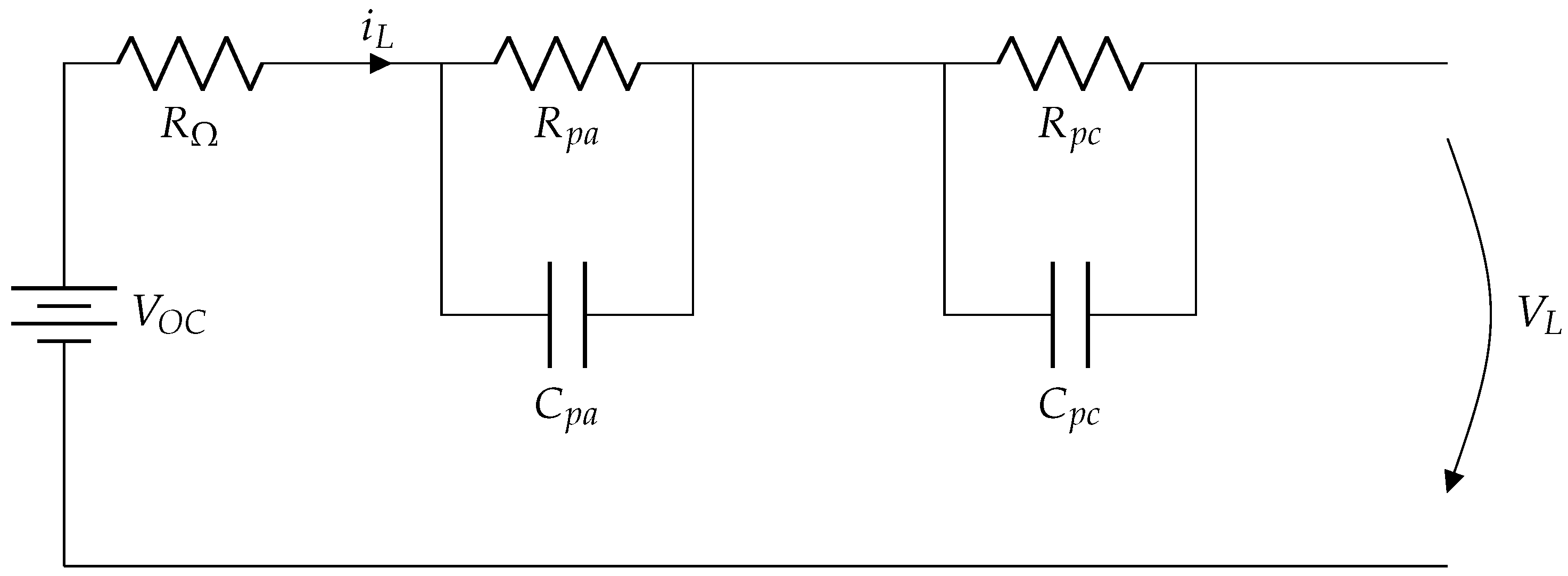
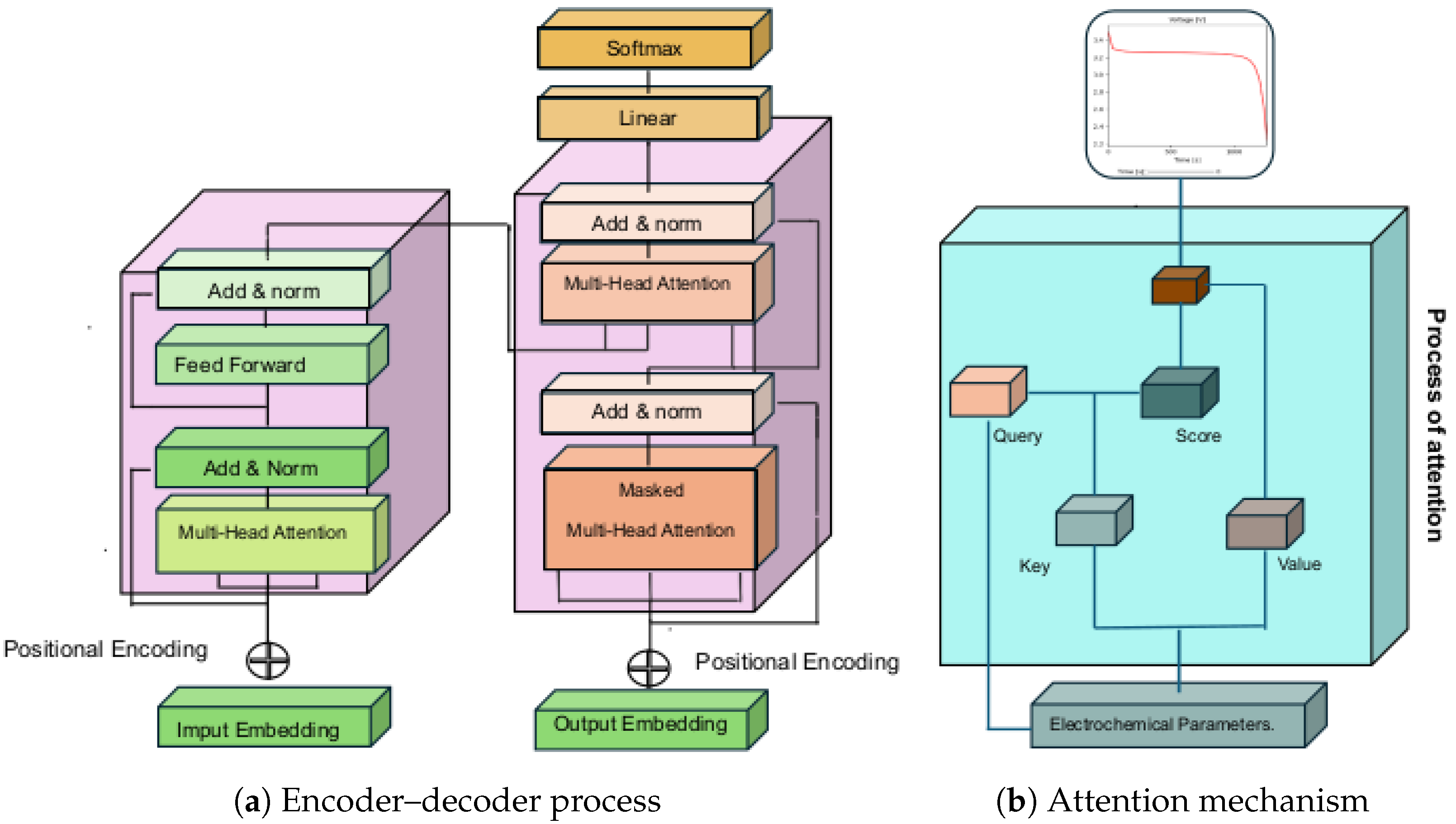
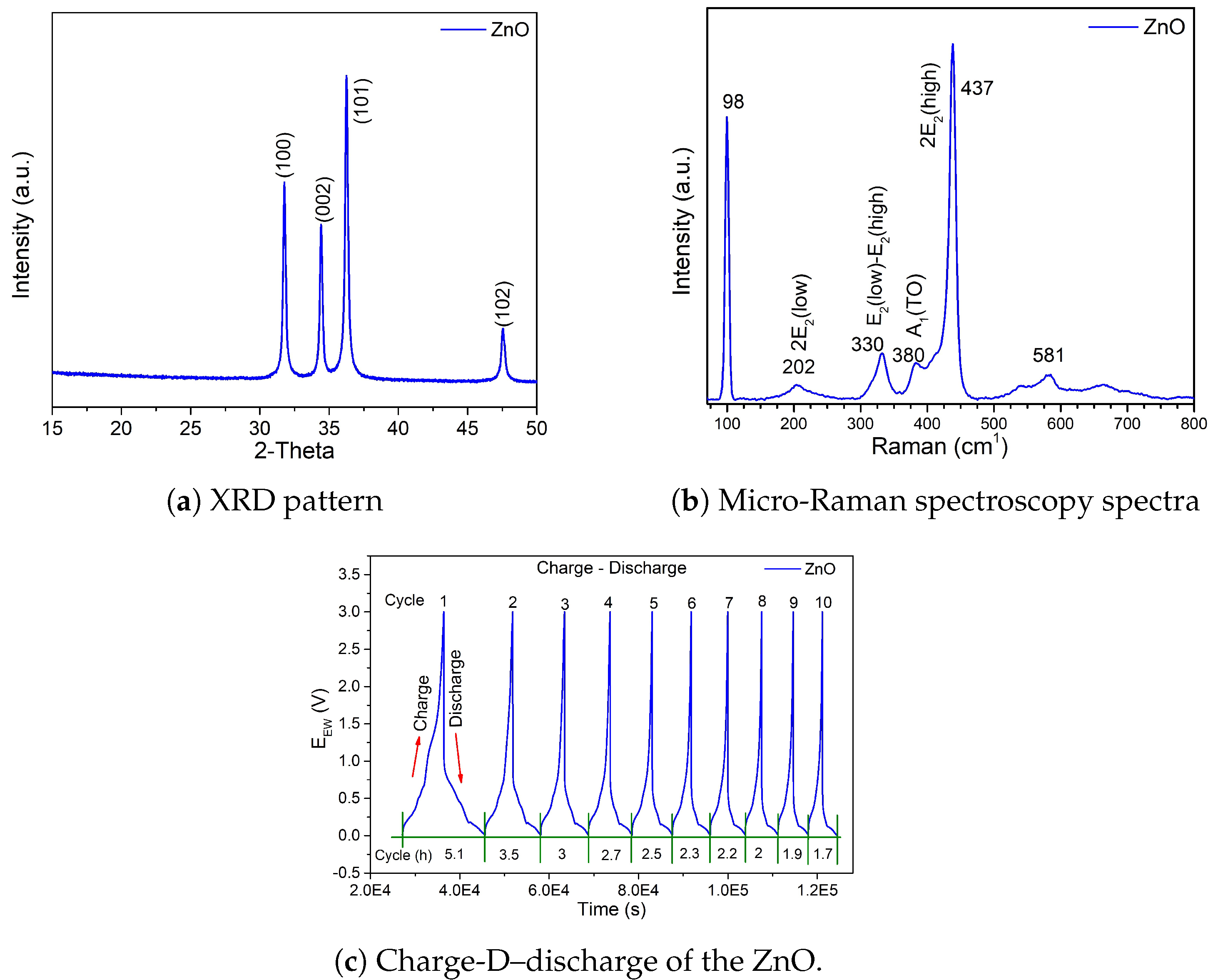
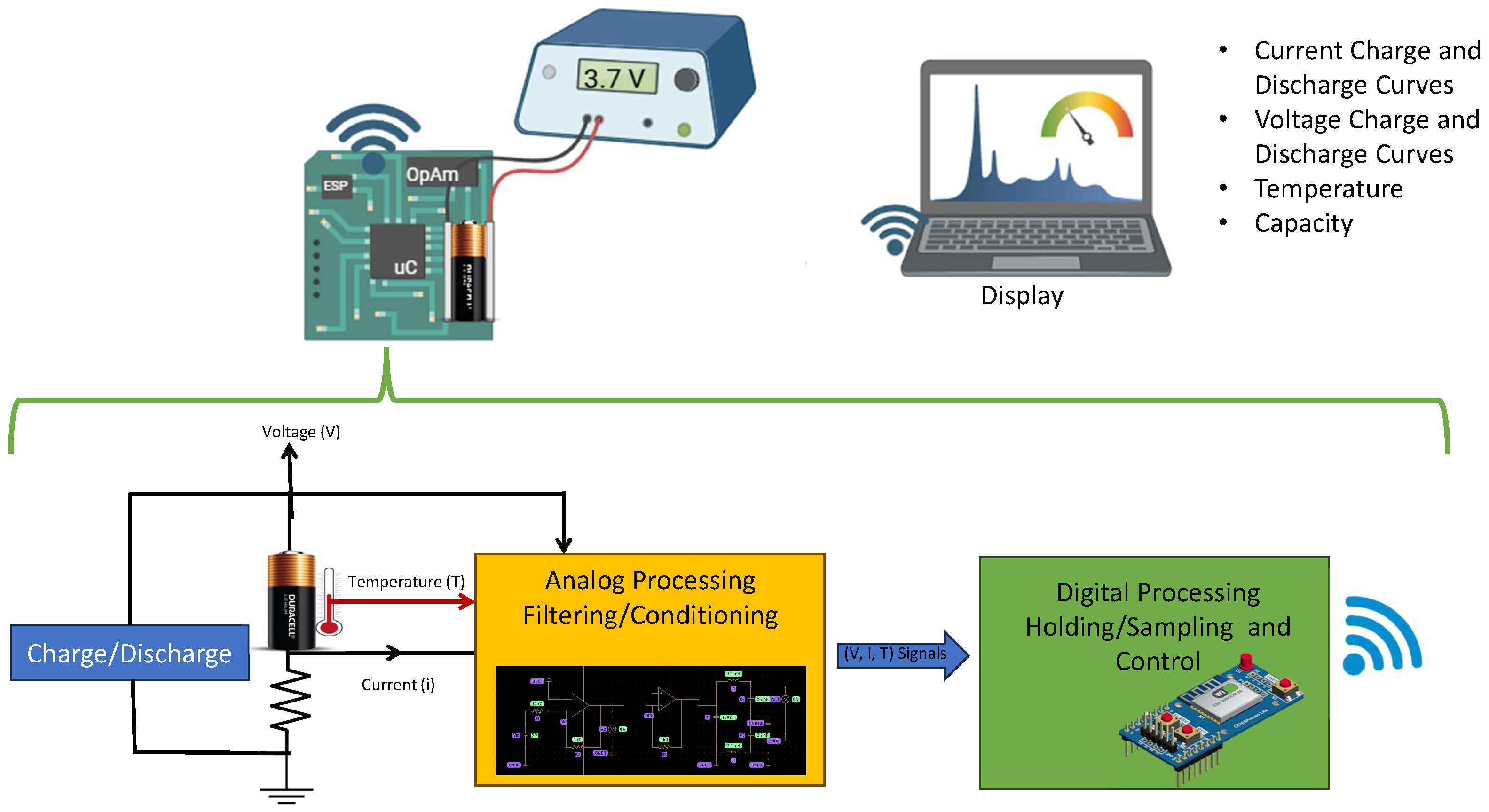
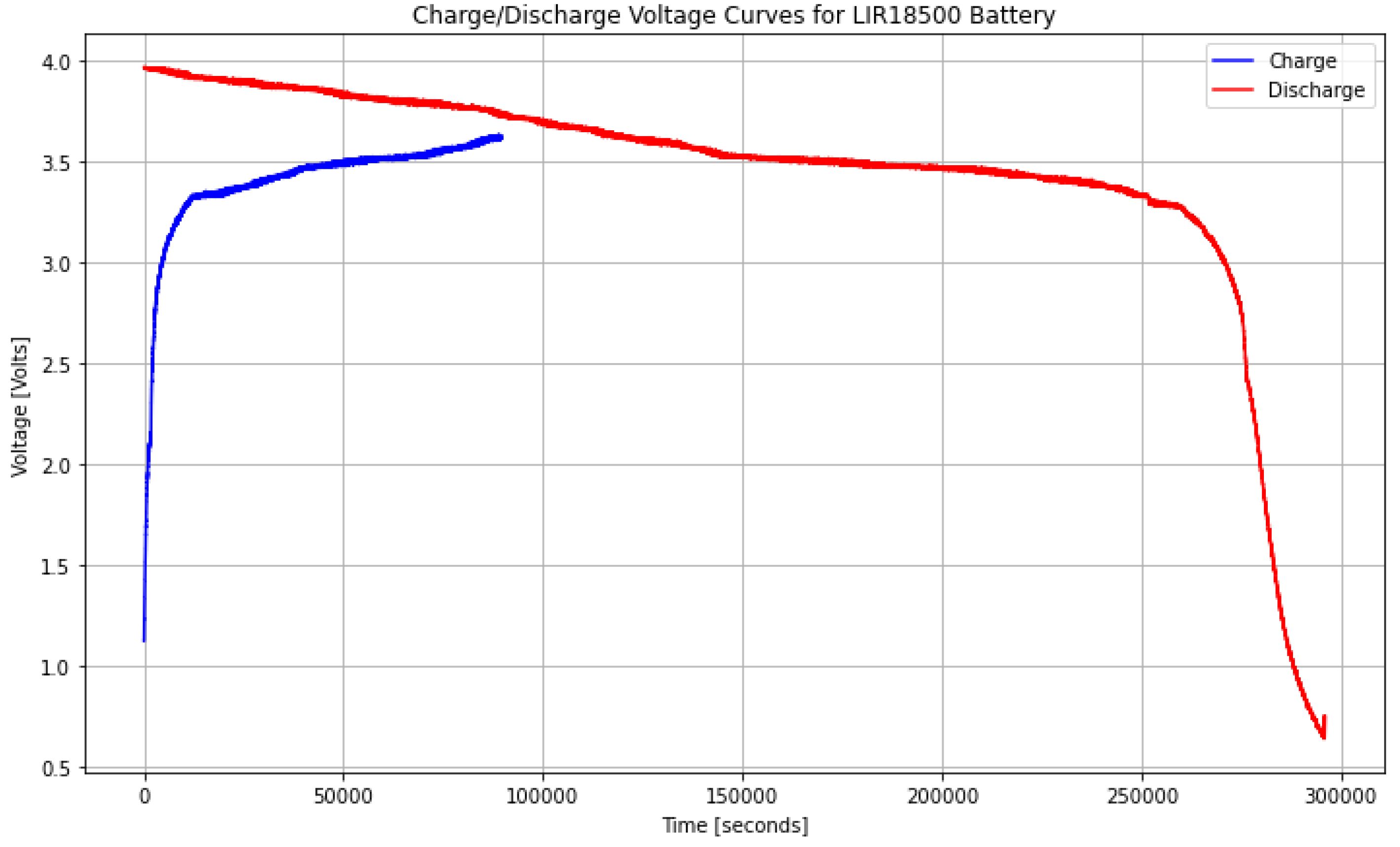
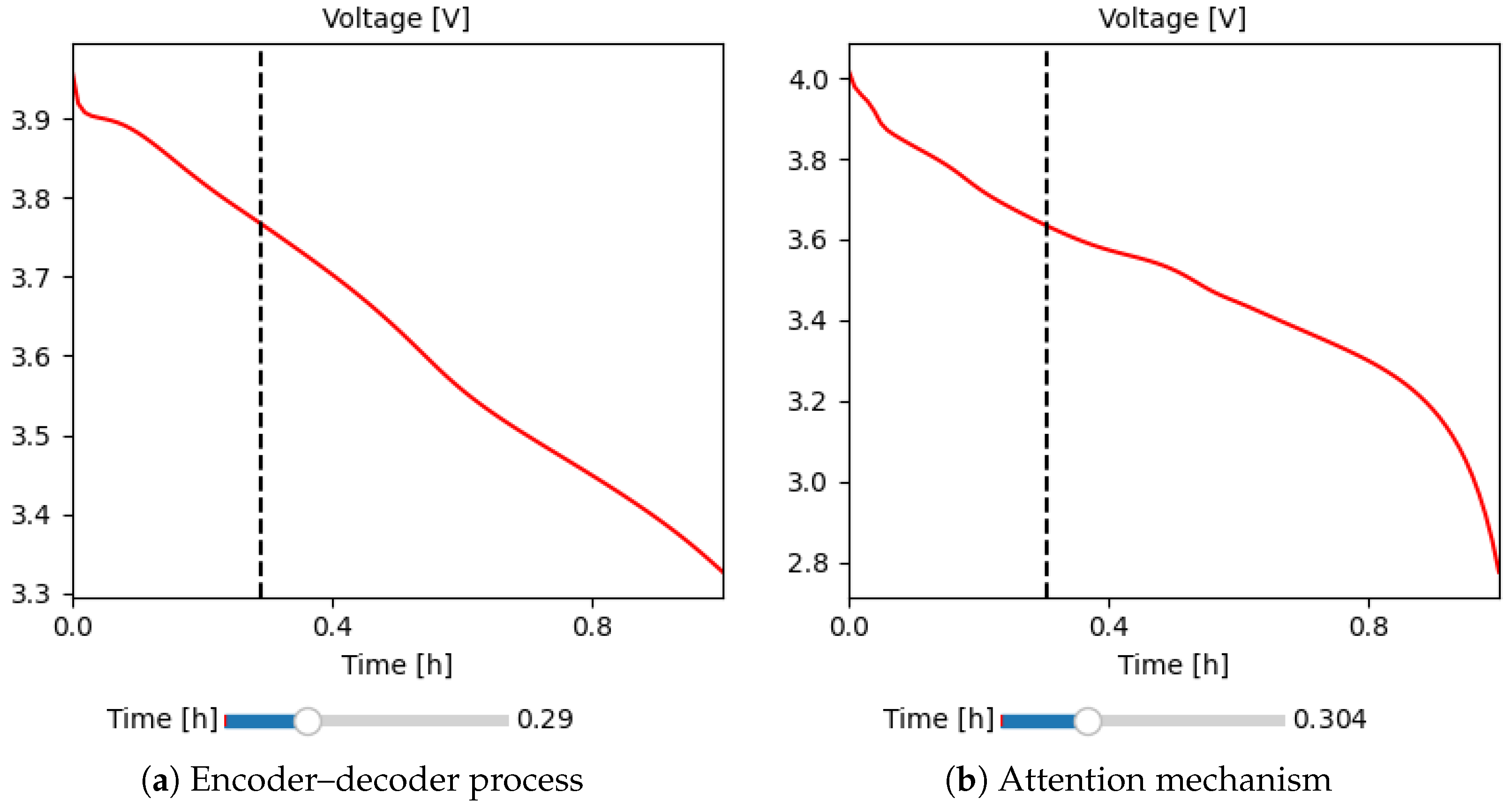
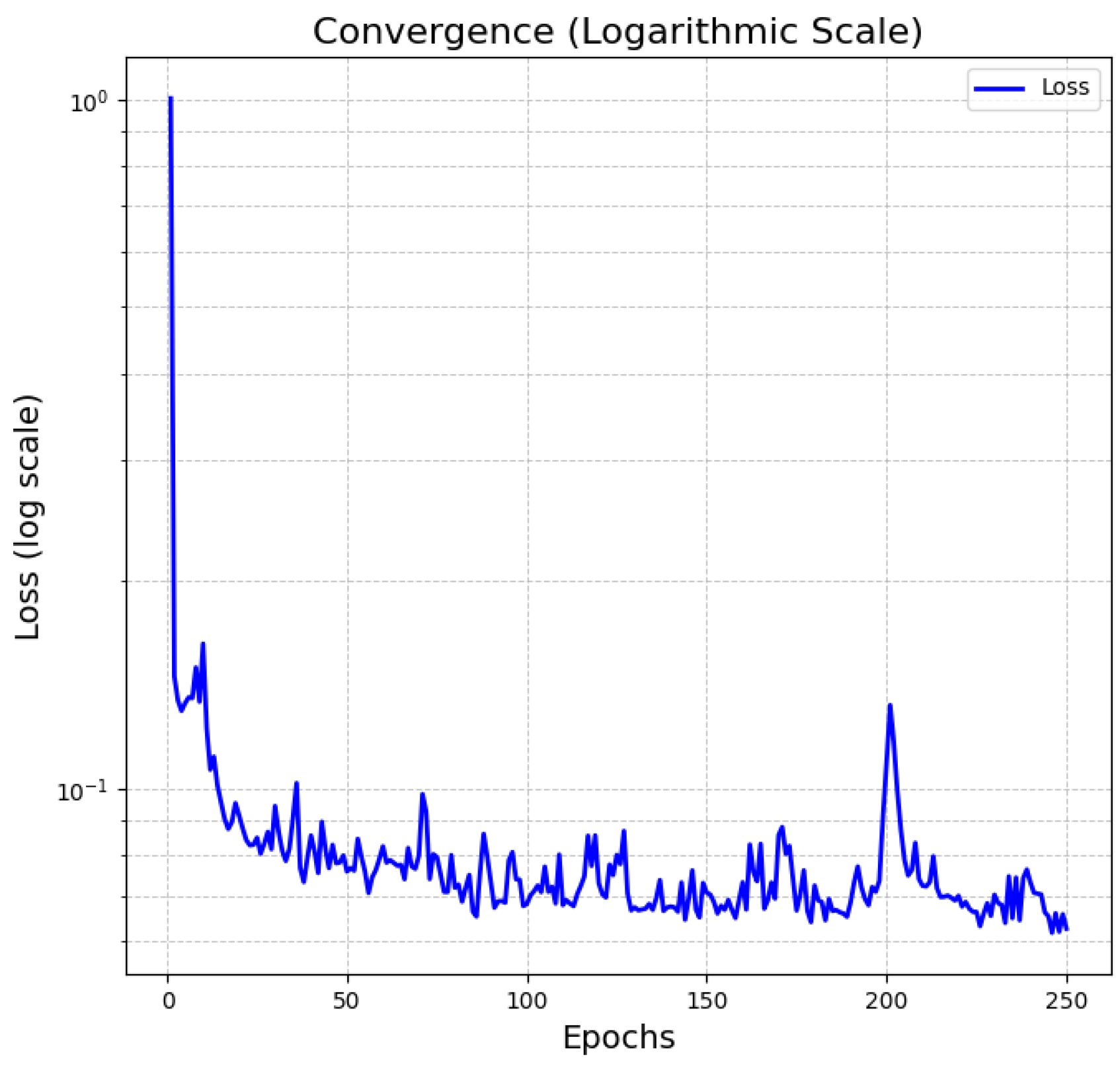
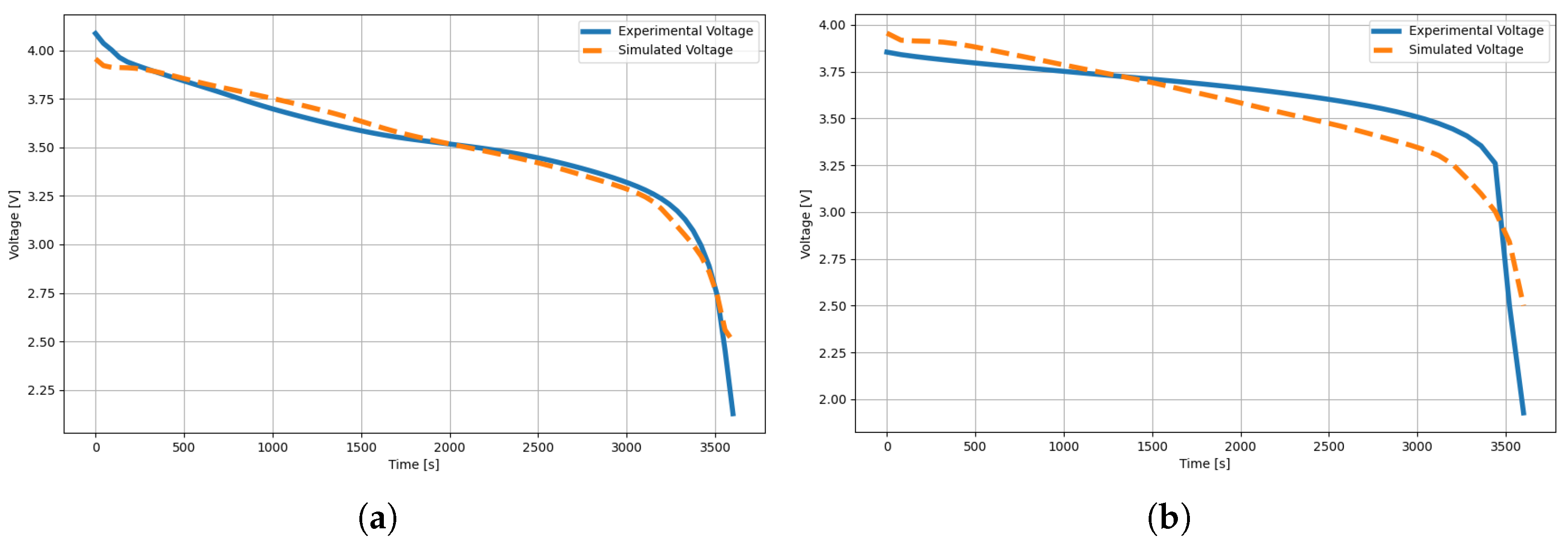
| Cycle Number | Q Discharge [mAh] | Percentage [%] |
|---|---|---|
| 0 | 3.100 | 100.00 |
| 1 | 1.440 | 46.36 |
| 2 | 0.969 | 31.22 |
| 3 | 0.833 | 26.83 |
| 4 | 0.761 | 24.52 |
| 5 | 0.704 | 22.67 |
| 6 | 0.658 | 21.19 |
| 7 | 0.611 | 19.67 |
| 8 | 0.570 | 18.35 |
| 9 | 0.526 | 16.94 |
| 10 | 0.486 | 15.67 |
| Electrochemical Parameters | Values |
|---|---|
| Negative electrode thickness | 8.4 × 10−5 [m] |
| Separator thickness | 1.0 × 10−5 [m] |
| Positive electrode thickness | 8.5 × 10−5 [m] |
| Maximum concentration in negative electrode | 30,000.0 [mol·m−3] |
| Outer SEI solvent diffusivity | 2.5 × 10−22 [m2·s−1] |
| Inner SEI lithium interstitial diffusivity | 1.0 × 10−20 [m2·s−1] |
| EC diffusivity | 2.0 × 10−18 [m2·s−1] |
| Negative electrode porosity | |
| Negative particle radius | 5.8 × 10−6 [m] |
| Maximum concentration in positive electrode | 63,104 [mol·m−3] |
| Positive electrode porosity | |
| Positive particle radius | 5.22 × 10−6 [m] |
| EC initial concentration in electrolyte | 1000 [mol·m−3] |
| Electrochemical Parameters | Values |
|---|---|
| Negative electrode thickness | 8.5 × 10−5 [m] |
| Separator thickness | 1.0 × 10−5 [m] |
| Positive electrode thickness | 1.0 × 10−3 [m] |
| Maximum concentration in negative electrode | 3000.0 [mol·m−3] |
| Outer SEI solvent diffusivity | 1.6 × 10−22 [m2·s−1] |
| Inner SEI lithium interstitial diffusivity | 1.0 × 10−20 [m2·s−1] |
| EC diffusivity | 2.0 × 10−18 [m2·s−1] |
| Negative electrode porosity | |
| Negative particle radius | 5.8 × 10−6 [m] |
| Maximum concentration in positive electrode | 63,104 [mol·m−3] |
| Positive electrode porosity | |
| Positive particle radius | 5.2 × 10−6 [m] |
| EC initial concentration in electrolyte | 1000.03 [mol·m−3] |
Disclaimer/Publisher’s Note: The statements, opinions and data contained in all publications are solely those of the individual author(s) and contributor(s) and not of MDPI and/or the editor(s). MDPI and/or the editor(s) disclaim responsibility for any injury to people or property resulting from any ideas, methods, instructions or products referred to in the content. |
© 2025 by the authors. Published by MDPI on behalf of the World Electric Vehicle Association. Licensee MDPI, Basel, Switzerland. This article is an open access article distributed under the terms and conditions of the Creative Commons Attribution (CC BY) license (https://creativecommons.org/licenses/by/4.0/).
Share and Cite
de Anda-Suárez, J.; Pérez-Zúñiga, G.; López-Ramírez, J.L.; Herrera Pérez, G.; Zeferino González, I.; Verde Gómez, J.Y., on behalf of the TecNM Energy Production and Storage Network. Lithium Battery Enhancement Through Electrical Characterization and Optimization Using Deep Learning. World Electr. Veh. J. 2025, 16, 167. https://doi.org/10.3390/wevj16030167
de Anda-Suárez J, Pérez-Zúñiga G, López-Ramírez JL, Herrera Pérez G, Zeferino González I, Verde Gómez JY on behalf of the TecNM Energy Production and Storage Network. Lithium Battery Enhancement Through Electrical Characterization and Optimization Using Deep Learning. World Electric Vehicle Journal. 2025; 16(3):167. https://doi.org/10.3390/wevj16030167
Chicago/Turabian Stylede Anda-Suárez, Juan, Germán Pérez-Zúñiga, José Luis López-Ramírez, Gabriel Herrera Pérez, Isaías Zeferino González, and José Ysmael Verde Gómez on behalf of the TecNM Energy Production and Storage Network. 2025. "Lithium Battery Enhancement Through Electrical Characterization and Optimization Using Deep Learning" World Electric Vehicle Journal 16, no. 3: 167. https://doi.org/10.3390/wevj16030167
APA Stylede Anda-Suárez, J., Pérez-Zúñiga, G., López-Ramírez, J. L., Herrera Pérez, G., Zeferino González, I., & Verde Gómez, J. Y., on behalf of the TecNM Energy Production and Storage Network. (2025). Lithium Battery Enhancement Through Electrical Characterization and Optimization Using Deep Learning. World Electric Vehicle Journal, 16(3), 167. https://doi.org/10.3390/wevj16030167








